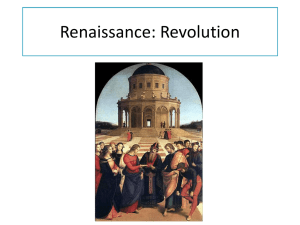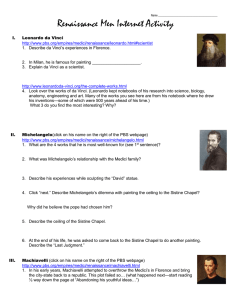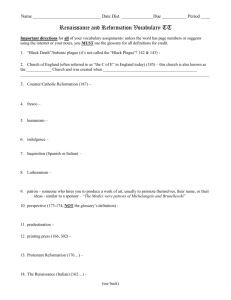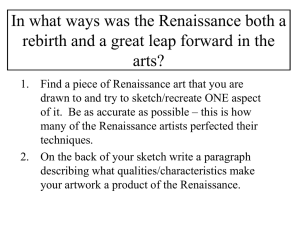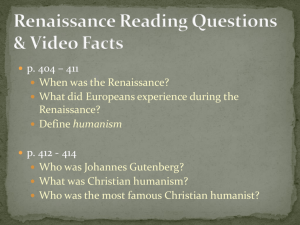Perspective! - Arlington Public Schools
advertisement
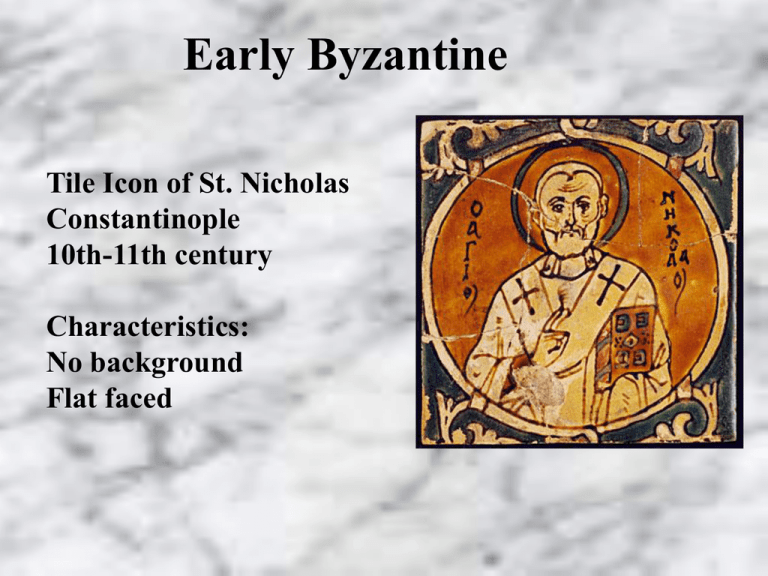
Early Byzantine Tile Icon of St. Nicholas Constantinople 10th-11th century Characteristics: No background Flat faced Icon of Christ Russian, Moscow Tempera on wood and gilded silver Middle Ages •saints in paintings wore halos around their heads •hieratic scale: representing the sizes of things according to their importance, rather than how they would appear in the real world •saints or members of the family of God larger in scale than ordinary or less important figures The Art of the Italian Renaissance The act of painting would no longer be to glorify God, as it had been in Medieval Europe. Painting in the Renaissance related instead, to those people looking at the painting. What was different in the Renaissance? Realism Perspective Classical (pagan) themes Geometrical arrangement of figures Light and shadowing (chiaroscuro) Softening of edges (sfumato) Backgrounds Artist able to live from commissions Art and Patronage Italians were willing to spend a lot of money on art. Art communicated social, political, and spiritual values. Italian banking & international trade interests had the money. Public art in Florence was organized and supported by guilds. Therefore, the consumption of art was used as a form of competition for social & political status! Characteristics of Renaissance Art 1. Realism & Expression Expulsion from the Garden Masaccio 1427 First nudes since classical times. 2. Perspective The Trinity Perspective! Perspective! Perspective! Perspective! Perspective! Masaccio 1427 Perspective! Perspective! First use of linear perspective! What you are, I once was; what I am, you will become. Discovery of Perspective: About 1420 Attributed to Brunelleschi Perspective produced a greater sense of realism All made possible through mathematics. 3. Classicism Greco-Roman influence. Secularism. Humanism. Individualism free standing figures. Symmetry/Balance The “Classical Pose” Medici “Venus” 1st C Birth of Venus Botticelli 1482–1486 4. Emphasis on Individualism Batista Sforza & Federico de Montefeltre: The Duke & Dutchess of Urbino Piero della Francesca, 1465-1466. 5. Geometrical Arrangement of Figures Leonardo da Vinci 1469 The figure as architecture! The Dreyfus Madonna with the Pomegranate 6. Light & Shadowing/Softening Edges Sfumato: Chiaroscuro: use of light and shade Ginevra de' Benci, a young Florentine noblewoman who, at the age of sixteen, married Luigi Niccolini in 1474. gradual blending of one area of color into another without a sharp outline 7. Artists as Personalities/Celebrities Giorgio Vasari 1550 Lives of the Most Excellent Painters, Sculptors, and Architects Biographies of Italian artists Giotto di Bondone Considered the first in a line of great artists who contributed to the Italian Renaissance 1267-1337 Giotto di Bondone Figures seem to exist in real space with recognizable human emotions. The camels: have blue eyes, ears like a donkey and feet like a cow. Had Giotto ever seen a camel in real life? Is the star Halley’s Comet which appeared in 1301? The Adoration Of The Magi 1304-06 A Contest to Decorate the Baptistry in 1401 Sacrifice of Isaac Panels Ghiberti Brunelleschi Ghiberti – Gates of Paradise Ghiberti wins. Made: 1425-1452 Michelangelo coins them the Gates of Paradise Piero della Francesca The Ideal City -1470 Sculpture David by Donatello 1430 First free-standing bronze since Roman times The statue originally belonged to Cosimo de' Medici, and was placed in the courtyard of the Palazzo Medici 15c What a difference a century makes! 16c The Renaissance Man Broad knowledge about many things in different fields. Deep knowledge/skill in one area. Able to link information from different areas/disciplines and create new knowledge. The Greek ideal of the “well-rounded man” was at the heart of Renaissance education. Self-Portrait da Vinci, 1512 Artist Sculptor Architect Scientist Engineer Inventor 1452 - 1519 Vitruvian Man Leonardo da Vinci 1492 The Last Supper - da Vinci, 1498 Geometry Refractory Convent of Santa Maria delle Grazie Milan 15 feet × 29 ft vertical The Last Supper - da Vinci, 1498 horizontal Perspective! Deterioration Detail of Jesus New technique that resulted in rapid deterioration Apostles First time Judas was painted as one of the twelve Mona Lisa Da Vinci 1503 Oil Poplar panel da Vinci carries it with him and the painting is next to him when he dies in France in 1519 Botticelli The Birth of Venus It depicts the goddess Venus, having emerged from the sea as a full grown woman, arriving at the sea-shore 1482–1486 Michelangelo Buonorrati 1475 – 1564 Born near Florence Adopted by Medici family He represented the body in three dimensions of sculpture. David 1504 Marble Heroic Intense High Renaissance 1500-1525 Associated with these three artists: da Vinci - Milan Raphael - Rome Michelangelo - Rome Renaissance Rome The High Renaissance The Sistine Chapel Michelangelo 1508-1512 About a year after creating David, Pope Julius II summoned Michelangelo to Rome to work on his most famous project, the ceiling of the Sistine Chapel. The Sistine Chapel’s Ceiling Michelangelo Buonarroti 1508 - 1512 Perspective Raphael Subjects are mainly secular, but can be religious Figures look idealized, but can also look like everyday ordinary people Bodies are active Clothed or unclothed Faces are expressive Detail The School of Athens 1510 Fresco Vatican City Plato: looks to the heavens -or the IDEAL realm. Painted as da Vinci Aristotle: looks to this earth-the here and now Marriage in the Renaissance Marriage vows were often treated like business contracts-carefully arranged marriage to strengthen business or family ties A dowry-a bride’s family's gift to the bridegroom A woman was expected to become a part of her new husband’s family Raphael Marriage of the Virgin-1529 Lorenzo the Magnificent Cosimo de Medici 1478 - 1521 1517 - 1574 Florence Under the Medici Medici Chapel The Medici Palace Other Famous Domes Il Duomo Florence St. Peter’s Rome St. Paul’s London US capital Washington
